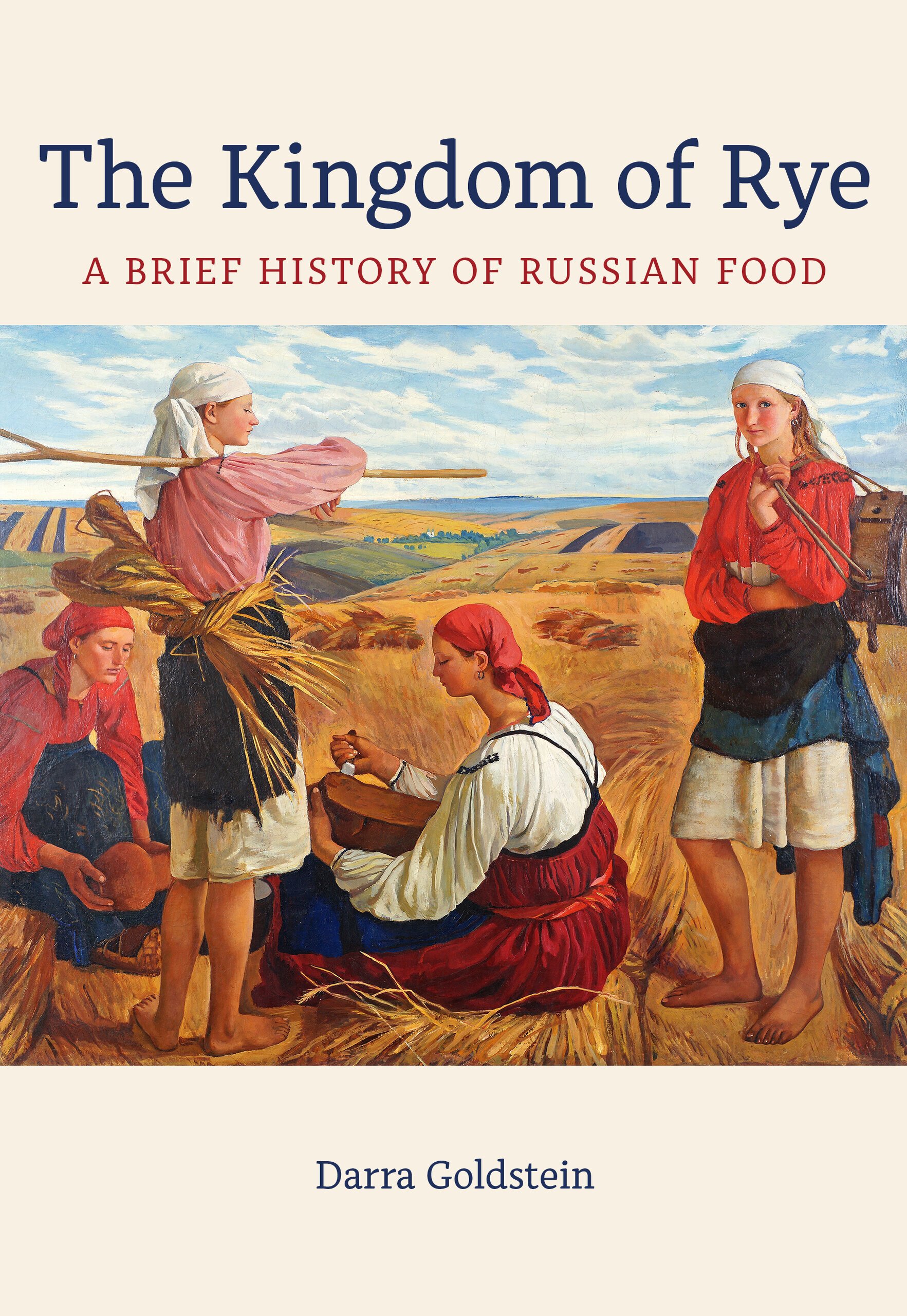The Kingdom of Rye: A Brief History of Russian Food
Russia is not Putin, though you’d hardly know it in current reporting. Nor has its culture been formed in isolation from the rest of the world. On the contrary, it has been shaped by its interactions with both the East and the West, influences that have for centuries confounded Russia’s sense of identity. Darra Goldstein tells this story through the lens of food. The Kingdom of Rye is a slender volume packed with the complexities of Russian history.
READ REVIEW
↓
The kingdom of rye
a brief history of russian food
darra goldstein | 2022
Goldstein has Russian heritage and inherited her ancestors’ love of the sour, the salty and the pungent. You can hear her salivating as she talks about rye bread, fermented cabbage, tvorog and smetana (both products of sour milk), though her descriptions of the use of honey in preserving and baking are mouth-watering too. The book starts with rye, since the 11th century the dominant grain in the Russian diet. Black bread has always been a staple. It is nutritious and slow to digest, so it staves off hunger. It is also a sacrament:
The alchemy of bread was awe-inspiring: the starter fermented, alive with bubbles, until the heat of the masonry stove – itself a life-giving force – transformed the simple mixture of flour into a solid loaf.
The book’s first chapter goes into detail about Russian foods and cooking methods, moving from bread to pies and the introduction of spices from medieval trade routes – Goldstein wants to dispel the notion of Russia’s isolation from the world. We learn about traditional beverages: fermented birch juice and honey (to make mead), kvass (made from stale rye bread), and the encroachment of vodka in the sixteenth century. More potent than other alcoholic drinks, vodka has caused problems ever since. As Goldstein relates (with a very unfortunate typo, when she misnames Tsar Nicholas II as Nicholas I), the state has made repeated interventions to prevent excessive alcohol consumption. Peter the Great replaced vodka with beer rations for those building his grand city in the north.
Russia’s imperial spread to Central Asia and the Caucasus brought warm-climate foodstuffs into the culinary lexicon. Dishes from Georgia and Azerbaijan, and Ukrainian dumplings (vareniki) were embraced in Soviet times as part of the ‘brotherhood of all peoples’. What about caviar, you ask? Its story is related to salt and Ivan the Terrible’s annexation of Siberia in the sixteenth century. The salt-rich Astrakhan region was also home to sturgeon, whose roe was salted to become black gold.
Goldstein’s aim is to ‘serve up a history that originates from the wooden spoon rather than from the sceptre’. While she does recount the opulence of aristocratic tables, much of the book focuses on ordinary people. Her middle chapter is about hardship and hunger. Russia’s climate, wars and disastrous agricultural polices in Tsarist and Soviet times all caused shortages, and too often famine. Goldstein explains how the Russian Orthodox Church codified seasonal patterns of hunger by designating nearly 200 days as fasting (that is no meat) days. She details the desperate measures people took during the Siege of Leningrad, like taking glue from book bindings and scraping wallpaper paste from the walls to retrieve the animal protein these contained.
Having myself lived in Moscow in late Soviet times, the accounts of empty shelves and long food queues, yet also miraculously well-laden tables of Russian friends, ring absolutely true. This paradox can be attributed to two things: the parallel economy of exchange that existed and the centrality of hospitality in Russian culture. Waiting in line for hours, coming together around the kitchen table, foraging for mushrooms and berries, and planting potatoes in a tiny plot at the dacha were all activities that helped to retain quintessential Russianness during the Communist period.
Then came McDonald’s! This was not the first encroachment from the West. The aristocracy had embraced many French tastes – and imparted others. Notable is service à la Russe, the habit of serving courses sequentially so that dishes stayed hot, rather than being opulent displays placed in the middle of the table where they got cold. Tea came from China – hence the Russian Caravan blend – in the early nineteenth century and became an essential part of Russian life, carefully brewed atop the samovar. Pepsi arrived in the 1970s.
The Kingdom of Rye contains an important coda on post-Soviet Russia. McDonald’s started a welcome trend of ‘service with a smile’, almost entirely absent in Soviet dining establishments. But then hyperinflation arrived and more tough times for many ordinary Russians, followed by sanctions that forced Russia to turn to its own supply chain once thousands of products could no longer be imported. What followed has been a revival of interest in traditional practices, with young people planting heritage crops, gathering wild foods and making ancient craft foods. As in other realms of the economy, domestic food outlets have entered the market, like the organic grocery Tasteville, and the chain of blini kiosks, Teremok.
At a time when tensions are high between Russia and the west, these developments are more than tinged with nationalism: Putin has managed to politicise food to fuel his anti-Western ardour. But in telling the history of Russian food, this book reveals a much more complex tale of Russia’s location in both Europe and Asia. Here is a country that is entwined in what are now global culinary trends, and a people with a ‘national longing for conviviality’. Our leaders would do well to bring Russia back to the table, to talk through our differences while breaking bread.
The Kingdom of Rye: A Brief History of Russian Food is published by University of California Press.
Reviewer: Francesca Beddie, PHA (NSW & ACT)

